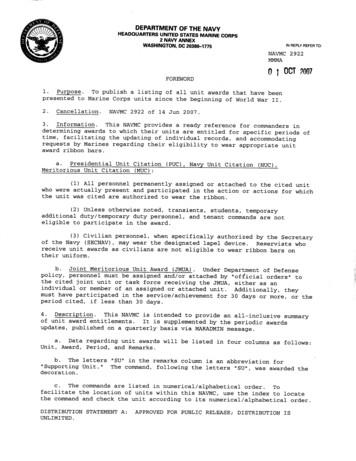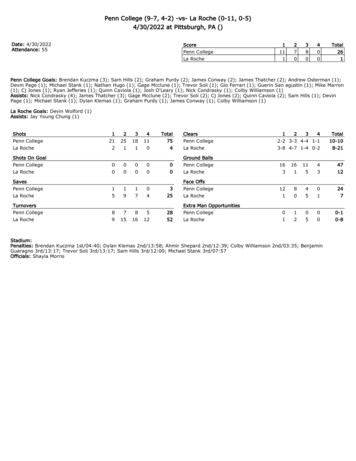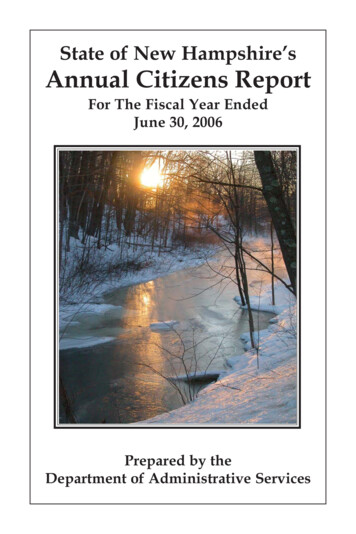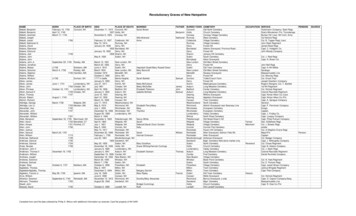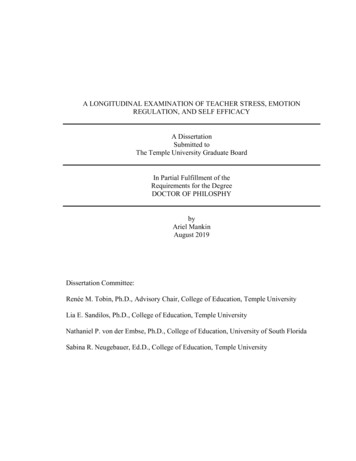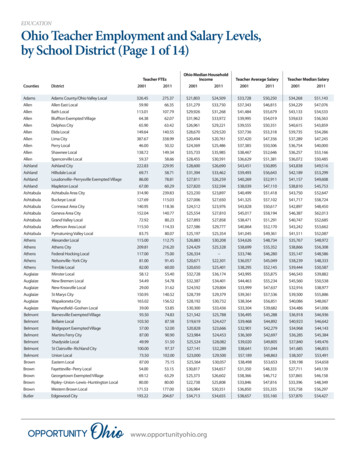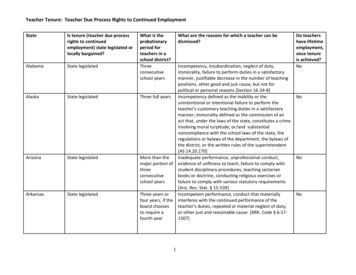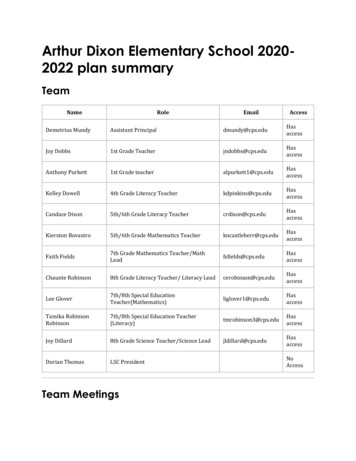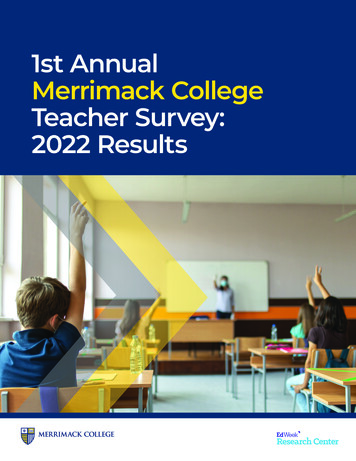
Transcription
1st AnnualMerrimack CollegeTeacher Survey:2022 Results
1st Annual Merrimack College Teacher Survey: 2022 ResultsExecutive SummaryAs teachers grapple with the fallout of a worldwideto nine years in the classroom and females are more likely to say theirpandemic and renewed attention to the culturesalaries are unfair, as are teachers who are dissatisfied with their jobs andwars in schools, their satisfaction rates appearthose who are likely to leave the profession in the next two years.to have hit an all-time low, according to theAutonomy is another indicator of satisfaction. While most teachersfirst annual Merrimack College Teacher Surveysay they have control over key aspects of their jobs—including theircommissioned by the Winston School of Education and Social Policyteaching/pedagogy, their curriculum, their students’ classroomat Merrimack College and conducted by the nonprofit, nonpartisanbehavior, the way that they assess their students, and the resources andEdWeek Research Center.supplies they need for instruction—just 37 percent say they have a lotThe survey results suggest a deep disillusionment of many teachersof influence over another critical area: scheduling. The typical teacherwho feel overworked, underpaid, and under-appreciated, with potentialworks 54 hours per week, 25 hours of which is spent teaching students.implications for a once-in-a-generation shift in the teaching profession.Although the amount of time spent teaching is relatively consistentFor example, just twelve percent of teachers, the survey found, are veryacross categories such as grade level and years of experience, Blacksatisfied with their jobs, with more than four in ten teachers saying theyteachers and teachers in majority-Black schools report working longerwere very or fairly likely to leave the profession in the next two years.hours and spending less of them on instruction.This yearly survey fills the gap left by MetLife’s former Survey of theOverall, most teachers say they’d like to spend more time onAmerican Teacher, which asked similar questions to gauge the state ofactivities directly related to teaching (planning, instruction) and lessthe teaching profession and highlight teacher voices and perspectives.time on more ancillary tasks (administrative work, non-teaching studentThe Merrimack College Teacher Survey was of 1,324 of the nation’sinteractions such as hall duty, mentoring, and counseling). This sense—teachers and conducted between January 9th and February 23rd, 2022,that too much time is spent on this more peripheral work, combined withand has a margin of error of plus or minus 3 percentage points with a 95the reality that most teachers say they lack control over their time andpercent confidence level.nearly half perceive they lack control over the curriculum they teach—The last two years have been fraught for teachers as their professionraises concerns that teaching is becoming a deprofessionalized job, onehas consistently attracted public attention—much of it hostile—due towhere educators are treated more and more like hourly employees withpolitical and cultural battles over pandemic-related policies on maskinglimited autonomy.and vaccines and new laws curtailing instruction related to race, racism,The challenges and frustrations that teachers face could take a toll onand gender. A factor that almost certainly contributes to their risingthe profession’s ability to sustain itself in the future. Forty-four percentdissatisfaction is teachers’ growing perception that the general publicof teachers say they are very or fairly likely to leave the profession in thedoes not understand or appreciate their work. Less than half of 2022next two years, up from 29 percent in the 2011 MetLife survey. Women,survey respondents say the general public respects them and viewsBlack teachers, teachers working in Southern states, and teachers withthem as professionals, down from 77 percent of 2011 respondents to thethree to nine years of experience are significantly more likely to sayMetLife survey. Most teachers also perceive that five of seven timely topicsthey plan to leave education. It’s important to note that based on currentincluded on the survey receive insufficient attention from the news media.research, it is unclear whether such intentions will translate into higherHowever, like other Americans, they are divided along partisan lines,actual attrition rates in this and coming school years.especially when it comes to issues of racism and race: While 54 percent ofGiven the challenges they face, would teachers advise their youngerteachers who traditionally vote for the Democratic party say that teachingselves to do it all again? On this, educators are split, with less than halfabout racism and race should get more attention from the news media,(45 percent) saying they would and the remainder saying they wouldjust 15 percent of self-identified Republicans agree.not. This sentiment, coupled with the finding that increasing numbersSalaries may be another reason so many teachers are dissatisfied.of teachers are at least contemplating leaving the profession, raisesTwenty-six percent of teachers say they are paid fairly for the work theyquestions about the future of the nation’s ability to sustain its criticaldo, down from 35 percent on MetLife’s 2011 survey. Teachers with threeK-12 teaching force. 2
IntroductionThe last two years have been some of the toughestteachers’ experiences and voices. MetLife discontinued the surveytimes teachers have faced in the past century. Forcedin 2012, and it is into this gap that the Winston School of Educationto pivot from one day to the next from in-personand Social Policy at Merrimack College launched the first annualto remote instruction while they dealt with falloutMerrimack College Teacher Survey. Conducted by the nonpartisan,from the worldwide coronavirus pandemic, K-12nonprofit EdWeek Research Center, the survey was designed andeducators found themselves stretched to the limit in an environmentupdated with feedback from over a dozen educational experts andin which severe staffing shortages have been coupled with intensepractitioners.political and social polarization that ignited or re-ignited fractiousThe 26-question survey was fielded online between Januarydebates about educational policies and practices. In a sense, these9th and February 23rd, 2022. A total of 1,324 public school teacherschallenges have brought K-12 education to an inflection point in whichresponded to the nationally-representative poll, including 497its very foundations and forms are potentially in flux.elementary school teachers, 245 middle school teachers, 495 highFor these reasons, it seemed like the ideal moment to takeschool teachers, and 87 who teach other grade configurations. Thethe pulse of the teaching profession. For more than a quartermargin of error for the survey is plus or minus 3 percentage pointscentury, the MetLife Survey of the American Teacher gave voice towith a confidence level of 95 percent.the views and experiences of teachers. The results were widelyThe results were shocking, yet given the challenges of the pastdisseminated in an effort to help the public better understandtwo years, not entirely unexpected.All images: E and iStock/Getty. 3
1st Annual Merrimack College Teacher Survey: 2022 ResultsTeacherSatisfactionIt is no secret that teachers have faced severechallenges during the worldwide coronaviruspandemic. Results of previous surveys suggestFigure 1All in all, how satisfied are you with your jobjob?that teacher morale has declined precipitouslyduring the pandemic, while stress rates haveskyrocketed.12%15%Still, at first glance, results of the MerrimackCollege Teacher Survey don’t necessarily appear toVery satisfiedbe alarming. The majority of teachers (56 percent)Somewhat satisfiedsay they are (somewhat or very) satisfied with theirSomewhat dissatisfiedjobs. (Figure 1)Very dissatisfiedHowever, these results represent a major28%downturn. Over time, the MetLife Survey of the44%American Teacher tracked the share of educatorswho were very satisfied with their jobs, findingthat job satisfaction was declining over time.The most recent results, collected in 2012, werereleased in accompaniment with dire warningsthat teacher job satisfaction had hit a 25-year lowafter peaking in 2008 at 62 percent. At that time,39 percent of teachers were very satisfied withtheir jobs.This year’s share of “very satisfied” teachers?Twelve percent. (Figure 2)Figure 2Percentage of K-12 teachers who saythey are ‘very satisfied’ with their 59%44%44%33%40%39%30%20%12%10%0%198 4198 5198 6198 7198 8198 919952 00 1 2 00 3 2 00 6 2 00 8 2 00 9*The 2022 results are from the Merrimack College Teacher Survey.The 1984-2012 results are from the MetLife Survey of the American Teacher. 4 2 0112 0122 02 2
1st Annual Merrimack College Teacher Survey: 2022 ResultsProfiles of TeacherSatisfactionProfile ofProfile ofteachers who are teachers who arevery satisfied very dissatisfiedwith their jobswith their jobsFigure 3ageGeneration Z6%0%The demographic profile of the least satisfied teachersMillennials15%40%differs from that of their most satisfied peers.Generation X45%45%Statistically, very satisfied teachers are more likelyBaby Boomers34%15%to be males, Baby Boomers, and elementary schoolyears of experienceeducators with more than 20 years of experience.Less than 3 yearsThe profile of the least satisfied teacher is a femaleMillennial middle school teacher with three to nineyears of experience. (Figure 3)Unsurprisingly, highly dissatisfied teachers havevery different perceptions of their jobs than do their9%6%3 To 9 years16%39%10 To 20 years42%40%More than 20 years33%16%genderhighly satisfied peers. They perceive lower levels ofFemale66%81%autonomy, professional support, and respect. TheyMale34%19%work longer hours and are more likely to say theirgrade level taughtsalaries are unfair for the amount of work they do.Elementary47%33%Middle12%19%High school31%35%Multiple grade levels10%12%515557%11%7%55%The general public82%30%Students' parents97%51%100%63%13%More than half say they’re very likely to leave theprofession in the next two years as compared to 11percent of their very satisfied counterparts.A very dissatisfied Colorado Millennial teachersummed it up like this in response to an open-endedmedian hours per week workedquestion asking respondents to share a story orsalaryperspective about one of the topics on the survey:Says salary is fair for the work he/she does“I do not know any teacher who is happy with theirwork this year. Many say they used to be happy tocome to work and since the pandemic we have beenat the tipping point. We need more money for oursalaries and for the school. New furniture for the kidsand more staff to help support the kids at every level.retentionVery likely to leave teaching profession in the next two yearsfeels respected/seen as a professional byWe are tired, we are underpaid and are worried aboutWithin his/her own schoolthe valuable staff we need, such as paraprofessionals,says he/she has a lot of control/influence overwho are paid even worse. We cannot continue in thisSchool policies65%way. we are tired.”Schedule (e.g., classes taught, non-academic duties)76%13%Students' classroom behavior95%53%Student assessment92%66%Teaching pedagogy99%74%14%31%for professional mentorship/support, turns toNobodyDistrict leaders69%21%School leaders87%45% 5
1st Annual Merrimack College Teacher Survey: 2022 ResultsRespectA consistent finding in the research is that teacher job satisfaction is linked to their sense of beingrespected. In the 2011 MetLife survey, for example, 77 percent of teachers perceived that theircommunities treated them as professionals and 59% were very satisfied with their jobs.It is therefore worrying that the Merrimack College Teacher Survey found just 46 percent ofteachers feeling that the general public respected them and saw them as professionals. (Figure 4)“A lot of times the feeling I get as a teacher is disrespect,” an Oregon elementary teacher wrotein response to an open-ended survey question. “I feel that media, parents, and even some studentsfeel that they can speak [to] our situation without even having a true sense of what massiveamounts of work we do. Sure, the lightbulb moments and the relationships with kids are what keepus going, but people have to know that teachers are struggling despite putting everything theyhave into their profession and craft every day. Pay is low, student learning discrepancies are higherthan ever after online learning, and it feels like not a lot is being done to remedy this. It probablysounds like a broken record when I say I feel over worked and underpaid and it feels like a patternof disrespect.”Although their job satisfaction rates are lower than those of white teachers (49 percent versus57 percent are satisfied), Black teachers are much more likely to feel a sense of respect: 71 percentperceive that the general public respects them and treats them as professionals as compared to 43percent of white teachers and 40 percent of Hispanic teachers.Figure 4Percentage of teachers who say the communitytreats them as professionals*The 2022 results are from the MerrimackCollege Teacher Survey. Prior results arefrom the MetLife Survey of the American20112022Teacher. In 2022, teachers were asked ifthey strongly or slightly agreed ordisagreed that they were respected andseen as a professional by the generalpublic. In 2011, teachers were asked toselect yes or no in response to thequestion: Are you treated as a professionalby the community? 6
1st Annual Merrimack College Teacher Survey: 2022 ResultsFemales, on the other hand, perceive lower levels of respect not only fromthe general public but from parents and even within their own schools.“Teaching is a female-dominated profession,” a female elementaryschool teacher in New York wrote in response to an open-ended surveyquestion. “As such, it's a battle for resources, respect, and a fair salary for thehours put in. If I could go back, I would choose a different career field. I neverimagined the constant battle and fast track to burnout.”Although female teachers, in general, perceive lower levels of respectthan do male teachers, an exception is the perception of parental respectat the elementary school level, where just 11 percent of teachers are male.Eighty-one percent of female elementary teachers—but just 65 percentof males—say their students’ parents and guardians respect them. Thereverse is true at the secondary level, where 36 percent of teachers aremale. Seventy-seven percent of male secondary teachers say their students’parents respect them as compared to 68 percent of females. (Figure 5)Figure 5I am respected and seen as a professional By students’ parents (or guardians)Within my school86%83%82% 81%86%82%81%80%77%74%65%By the general public77%74%74%68%52%51%50%46%45%40%Female elementaryteachersMale elementaryteachersFemale secondaryteachersMale secondaryteachersAll females 7 All malesTOTAL
1st Annual Merrimack College Teacher Survey: 2022 ResultsShelter From the Storm:Where Teachers Turn for SupportGiven the low levels of respect most teachers say they get from thegeneral public and some teachers say they also encounter at school,where do educators turn for support?Considering that so many feel that they—and their profession—areunder siege, it is perhaps unsurprising that teachers are most likely toseek support from one another. They are relatively less likely to seeksupport from administrators.“I am currently feeling very supported by my colleagues,” aCalifornia high school teacher wrote in response to an open-endedsurvey question. “They are there for me in a very positive way. WhereI am not feeling supported is the top-down implementation of policyfrom individuals who have been out of the classroom too long, and donot take advice or input from those of us who are actually in the field!”(Figure 6)Novice teachers in the first two years of their careers are also verylikely to turn to mentors (92 percent).Figure 6These are people I turn to for professionalmentorship and supportMy fellow teachers or colleagues in my school93%My fellow teachers or colleagues outside of my school77%My friends and family74%67%My mentors64%My school leaders (such as dept. chairs; asst. principals; etc.)33%My district leaders (such as curriculum leaders; superintendents)22%I do not turn to anyone for mentorship or support related to my profession 8
1st Annual Merrimack College Teacher Survey: 2022 ResultsEducation in the Public EyeGeneral perceptions of teachers are shaped by the portrayal of thereleased by four professional teacher organizations (the National Councilprofession in the news media and other venues for public discourse.for the Social Studies, National Council of Teachers of Mathematics,During the pandemic in particular, schools have received more attentionNational Council of Teachers of English, National Science Teachingthan usual due to challenges related to closures designed to stop theAssociation), and the National Coalition Against Censorship.spread of COVID, widespread staffing shortages exacerbated byFor the survey, teachers were asked whether they thought that sevenquarantines and illness, and debates over policies governing vaccines andtimely topics are getting too much, too little, or just the right amountmasks. In addition, culture wars over curricula have reignited in the pastof news media attention. Overall, the majority of teachers say five ofyear, with more than 40 states taking steps to place limits on instructionthe seven topics deserve more attention (teachers’ working conditions,about racism, gender, and/or race. Book banning is on the rise, schoolschool funding, student mental health, students’ disrupted learning, andboard members are reporting threats to their lives, and school sports haveeducational inequities related to poverty and race). They are split when itbecome ground zero for battles over transgender rights. It is noteworthycomes to the amount of attention paid to teaching about race/racism andthat a joint statement about “The Freedom to Teach” was recentlystandardized testing. (Figure 7)Figure 7Some educational issues always seem to be in the news. Othereducational issues never seem to be in the news, but should be.Which of these issues deserve less or more attention?Should get less attentionIs getting appropriate attentionShould get more attentionNot sure2%Teachers’ working conditions/school climateSchool fundingStudents’ mental health issues/traumaStudents’ disrupted learning and academic successThe inequities in our schools due to issues of race or povertyTeaching about race and racism12%3%85%16%7%78%23%10%28%28%The role of standardized tests at the pre-K-12 level30%39%*Totals may not add up to 100% due to rounding. 9 3%68%29%13%2%20%58%4%56%4%36%36%6%5%2%
1st Annual Merrimack College Teacher Survey: 2022 ResultsLike other Americans, teachers are politically divided whenit comes to their perceptions of the amount of attention the newsmedia should pay to different topics.Although Republicans and Democrats disagree on allseven topics included on the survey, the two topics with thebiggest political divides are teaching about race and racism andeducational inequities related to poverty and race. Fifty-fourpercent of Democrats but just 10 percent of Republicans say thenews media should pay more attention to teaching about raceand racism. Similarly, 77 percent of Democrats and 29 percent ofRepublicans say the media should attend more to the inequitiesin our schools due to issues of race or poverty. (Figure 8)Figure 8P e rc e n ta g e of teacherste a c h e rs whow h o says a y theseth e s e topicstop ic sPercentages h ou ld getg e t morem ore median e w s mattentione d ia a tte n tionshould15%32%Teaching about race and racism54%10%33%32%The inequities in our schools due to issues of race or poverty77%29%29%30%The role of standardized tests at the pre-K-12 levelDoes not vote42%Third party30%Democrat65%Republican60%Students’ mental health issues/trauma74%62%57%59%Students’ disrupted learning and academic success51%69%69%73%School funding84%73%82%77%Teachers’ working conditions/school climate90%78% 10
1st Annual Merrimack College Teacher Survey: 2022 ResultsFigure 9P e rc e n ta g e ofof teacherste a c h e rs whow h o says a y theseth e s e topicstop ic sPercentaged e s e rve morem ore newsn e w s mediam e d ia attentiona tte n tiondeserve81%84%82%Teachers’ working conditions/school climate93%79%91%94%82%School funding73%83%73%68%86%75%52%Students’ mental health issues/trauma70%73%60%The inequities in our schools due to issues of race or poverty78%78%27%79%28%73%74%53%Urban Republican67%Students’ disrupted learning and academic success53%73%55%31%Suburban RepublicanSuburban Democrat62%10%Teaching about race and racismRural Republican60%7%Rural Democrat48%31%The role of standardized tests at the pre-K-12 levelUrban Democrat46%28%47%34%34%Figure 10Like other Americans, teachers also demonstrate an urban-suburbanrural divide. Although dwarfed by partisan divides, this locale basedIn general, which political partydo you traditionally vote for?divide is evident when it comes to certain issues. For example, urbanRepublicans are roughly three times as likely as suburban or ruralRepublicans to say that the news media should pay more attentionto teaching about racism and race. And suburban Republicans are6%significantly less likely than their rural or urban Republican counterparts9%to call for the media to pay more attention to student mental health and30%trauma. (Figure 9)The Republican PartyThe Democratic PartyOverall, 54 percent of teachers told us they typically voted for theA third partyDemocratic Party. Thirty percent said they typically voted Republican.I do not voteNine percent said they voted for a third party and 6 percent said they didnot vote. This is in line with the profile of the typical teacher (a white,college-educated female): A 2018-19 Pew Research Center analysis of54%registered voters found that 62 percent of white college females areDemocrats and 34 percent are Republicans. (Figure 10) 11
1st Annual Merrimack College Teacher Survey: 2022 ResultsSalariesTeacher salaries are among the most high-profile ofeducation issues and are the focus of often-politicizeddebates.Figure 11MyM y salarys a la ry is fairfa ir for theth e workw ork I dodoIn 2011-12, the average teacher salary was 56,062.That year, 35 percent of MetLife Survey of the American7%Teacher respondents said their pay was fair for the workStrongly agreethey did.Slightly agreeThe most recent data available is from 2020-21.18%Slightly disagreeThat year, the average teacher salary was 65,090, theequivalent of a .88 percent increase in constant dollarsover the prior ten years. In the meantime, the share ofStrongly disagree51%teachers who say their salary is fair has declined by 9percentage points, or 26 percent. Currently, 26 percentof teachers strongly or slightly agree that their salaries23%are fair for the work they do, according to the MerrimackCollege Teacher Survey. (Figure 11)Like salaries themselves, salary satisfaction ratesvary by region. They are highest among teachers in theWestern United States (35 percent), which is dominatedby California, home to the second-highest teacher salaryin the nation ( 82,746). They are nearly the same in theNortheast (32 percent), home to New York, which has thenation’s highest average teacher salary ( 85,479).Salary satisfaction rates are lowest in the SouthernFigure 12PercentP e rc e n t of teacherste a c h e rs whow h o says a y theirth e ir salariess a la rie sarea re fairfa ir for theth e workw ork theyth e y dodoand Midwestern United States, where 21 percent ofteachers say their pay is fair for the work they do. TheSouth and Midwest are home to the states that have the34%nation’s three lowest average teacher salaries: Mississippi29%26%( 45,105), West Virginia (47,681), and South Dakota( 48,204).20%As is the case with most professions, men earn morethan women in teaching. One reason may be that menare concentrated at the secondary level, where pay issometimes higher and there are more opportunitiesto earn stipends for additional work such as coaching.However, while female secondary teachers are moreFemale elementaryteacherslikely than female elementary teachers to say their pay isfair, they are less likely than male secondary teachers tosay they’re earning what they deserve for the work theydo. (Figure 12) 12 Male elementaryteachersFemale secondaryteachersMale secondaryteachers
1st Annual Merrimack College Teacher Survey: 2022 ResultsIn most schools, teachers receive salary increasesFigure 13based on seniority. Accordingly, salary satisfactionrates are highest among the most experiencedteachers with more than 20 years of experience (34Percent of teachers who say their salariesare fair for the work they dopercent). (Figure 13)Between 1994 and 2015, the gap between the34%average weekly salaries of public school teachers andother similar (college-educated) employees grew from1.8 percent lower to 17 percent lower. Perhaps because27%25%they remember these relatively positive times, Baby18%Boomers are significantly more likely to say theirsalaries are fair (34 percent) than are members ofGeneration X (25 percent); Millennials (23 percent); ormembers of Generation Z (26 percent).Less than 3 yearsteaching 13 3 to 9 years teaching10 to 20 years teachingMore than 20 yearsteaching
1st Annual Merrimack College Teacher Survey: 2022 ResultsAutonomyAutonomy is a key indicator of job satisfaction, with employeesteacher alone every single year,” she wrote. “Class assignments comeexperiencing higher levels of morale and lower turnover rates whenout with about two week’s notice of the start of school, which frustratesthey have more control over their work environments. By severaland confuses me. I have so far written curriculum from scratch,measures, teachers express fairly strong rates of autonomy, with thewithout a textbook, alone, in the first weeks of August for Physics,majority of survey respondents reporting that they have a lot of controlHonors Physics, Standards Based Chemistry, Standards Based Physics,and influence over their teaching/pedagogy, their students’ classroomStandards Based Honors Physics, Pre AP German 3, Pre AP German 4,behavior, the way that they assess their students, and the resources andpost-COVID German 2, all within my first four years of teaching.”supplies they need for instruction. (Figure 14)Strong curricular control is also significantly more common amongThe majority of teachers (57 percent) also say they have a lot ofteachers in the West (65 percent) and the Northeast (63 percent) thancontrol over the curriculum that they teach. However, high schoolin the Midwest (56 percent) or the South (51 percent). It’s less commonteachers are significantly more likely to say this is the case (69 percent)in schools where most of the students are from low-income families:than their middle school (48 percent) or elementary school (44 percent)Fifty-one percent of teachers at schools where three-quarters or more ofpeers. While this is undoubtedly appealing to many high school teachers,students come from low-income families say they have a lot of curricularin a response to an open-ended survey question, a Missouri high schoolcontrol as compared to 71 percent where less than a quarter of studentsteacher four years into her career described it as overwhelming:come from low-income families.“Personally, I have had to write curriculum from scratch as a new“As a teacher I have no control over the curriculum or how to teachFigure 14I have control and influence over Strongly AgreeSlightly AgreeMy teaching/pedagogyMy students’ classroom behaviorThe ways I assess my studentsThe curriculum I teachThe resources and supplies I need to teachMy schedule (such as classes I teach and nonacademic duties I take on)My school’s policies*Totals may not add up to 100% due to rounding. 14 Slightly DisagreeStrongly Disagree
1st Annual Merrimack College Teacher Survey: 2022 Resultsit,” said a survey respondent in Ohio, who works at an elementaryschool where more than three-quarters of the students qualify for freeor reduced-price meals. “We are so focused on teaching to the test thatdifferentiation is not happening.”Educators are even less likely to say they have a lot of control overscheduling issues than to say they have a lot of control over curriculum.Thirty-seven percent say they strongly influence factors such as theclasses they teach, or the non-academic duties they take on.“I have not had more than 15 minutes for lunch all year and mustsupervise my students during lunch making it tough to interact withother professionals, come up with innovative ideas and consult aboutstudents,” wrote a Virginia high school teacher in response to an openended survey question.Said a New Jersey elementary school teacher: “Since we returnedafter quarantine, I now do 1.5 extra hours a day of DUTY. This infringeson my time to prepare for my classes effectively.”Next to general administrative tasks, non-teaching studentinteractions like hall or lunch duty are the aspect of their jobs teacherswould most like to spend less time on.Teachers are even less likely to say they influence their school’spolicies than to say they influence scheduling. Just 1 in 3 say they have alot of influence over this aspect of their work.“I wish that I had more control of the policies that take place in myclassroom,” a Washington high school teacher wrote in response to anopen-ended survey question. “For example, I am forced to bicker atstudents daily about being on their phones even if they've completed alltheir assig
This yearly survey !lls the gap left by MetLife's former Survey of the American Teacher, which asked similar questions to gauge the state of the teaching profession and highlight teacher voices and perspectives. The Merrimack College Teacher Survey was of 1,324 of the nation's teachers and conducted between January 9th and February 23rd, 2022,
